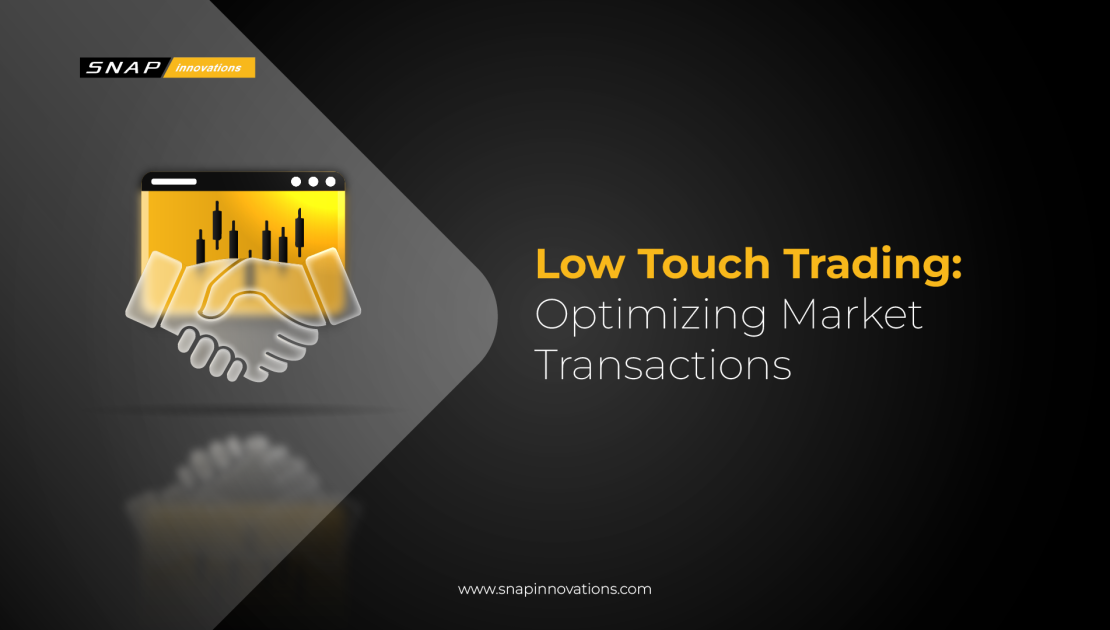In the fast-paced world of financial markets, efficiency is paramount. Traders and investors seek streamlined processes that enable swift execution of orders with minimal manual intervention. Low touch trading emerges as a solution, leveraging technology to automate and optimize market transactions. This article explores the concept of low touch trading, its benefits, challenges, and its role in shaping the future of financial markets.
Low touch trading, also known as electronic trading, refers to the execution of trades with minimal human intervention. Unlike high touch trading, which involves extensive interaction between traders and brokers, low touch trading relies on automated algorithms and electronic platforms to execute orders swiftly and efficiently. By leveraging advanced technology and algorithms, low touch trading enables traders to execute large volumes of trades across multiple asset classes with unparalleled speed and precision.
What is Low Touch Trading
 Low touch trading, a pivotal component of modern financial markets, represents a transformative approach to executing trades with minimal human intervention. At its essence, low touch trading leverages cutting-edge technology and automated algorithms to facilitate seamless and efficient trade execution across various asset classes. Unlike traditional high touch trading methods, which rely heavily on human brokers and manual processes, low touch trading harnesses the power of electronic platforms and sophisticated algorithms to execute trades swiftly and accurately.
Low touch trading, a pivotal component of modern financial markets, represents a transformative approach to executing trades with minimal human intervention. At its essence, low touch trading leverages cutting-edge technology and automated algorithms to facilitate seamless and efficient trade execution across various asset classes. Unlike traditional high touch trading methods, which rely heavily on human brokers and manual processes, low touch trading harnesses the power of electronic platforms and sophisticated algorithms to execute trades swiftly and accurately.
This approach not only accelerates the pace of trade execution but also mitigates the potential for human error, enhancing overall efficiency and precision in market transactions. By automating routine trading activities and leveraging data-driven insights, low touch trading empowers traders to capitalize on market opportunities in real-time while minimizing operational costs and risks. Furthermore, low touch trading encompasses a diverse range of strategies, including algorithmic trading, program trading, smart order routing, and direct market access (DMA), each tailored to optimize trade execution and maximize returns for market participants.
In essence, low touch trading represents a paradigm shift in the way financial markets operate, streamlining processes, enhancing liquidity, and democratizing access to investment opportunities for traders and investors worldwide. As technology continues to evolve and regulatory frameworks adapt, low touch trading is poised to play an increasingly integral role in shaping the future of finance, driving innovation and efficiency in market transactions.
The Benefits of Low Touch Trading
 Low touch trading offers numerous benefits for traders, investors, and market participants. Let’s delve deeper into the benefits of low touch trading with extensive elaboration on each point:
Low touch trading offers numerous benefits for traders, investors, and market participants. Let’s delve deeper into the benefits of low touch trading with extensive elaboration on each point:
1. Enhanced Efficiency
Low touch trading represents a revolutionary approach to trade execution, leveraging sophisticated algorithms and electronic platforms to streamline the transaction process. By automating various aspects of trading, such as order placement, routing, and execution, low touch trading significantly reduces the time and effort required for trade execution.
Traders can swiftly execute orders with minimal manual intervention, eliminating the need for time-consuming phone calls or manual order entry. This enhanced efficiency not only accelerates trade execution but also enables traders to capitalize on market opportunities in real-time, giving them a competitive edge in today’s fast-paced financial markets.
2. Cost Reduction
One of the most compelling benefits of low touch trading is its ability to reduce trading costs for market participants. By minimizing the need for human intervention and manual processes, low touch trading eliminates the high costs associated with traditional high touch trading methods.
Human brokers, who typically charge hefty commissions for their services, are replaced by automated algorithms and electronic platforms, resulting in significant cost savings for traders and investors. Moreover, the automation of trade execution reduces the likelihood of errors and trade discrepancies, further lowering operational expenses and minimizing the risk of costly mistakes.
Also Read: Open Source Trading Platform: Empowering Financial Markets
3. Improved Trade Execution
Low touch trading algorithms are designed to execute trades at optimal prices and timings, maximizing trade execution quality and minimizing slippage. These algorithms analyze vast amounts of market data, including price movements, order book dynamics, and trading patterns, to identify trading opportunities and execute orders with precision.
By leveraging advanced analytics and real-time market insights, low touch trading platforms ensure that trades are executed at the most favorable prices available in the market, maximizing potential returns for traders and investors. Additionally, the automation of trade execution eliminates the emotional biases and behavioral tendencies that can often lead to suboptimal trading decisions, resulting in more disciplined and consistent trade execution.
4. Increased Liquidity
Low touch trading strategies play a crucial role in enhancing market liquidity by providing liquidity providers and market makers with the ability to execute trades rapidly and efficiently. By facilitating the flow of orders and transactions, low touch trading platforms contribute to the overall liquidity of financial markets, reducing bid-ask spreads and minimizing price volatility.
Moreover, the increased liquidity provided by low touch trading platforms enhances market efficiency and stability, making it easier for traders to enter and exit positions at competitive prices. As a result, traders benefit from improved liquidity conditions, reduced trading costs, and enhanced price discovery, ultimately leading to a more efficient and vibrant marketplace.
5. Enhanced Market Access
Low touch trading platforms offer traders unparalleled access to a diverse range of markets, asset classes, and trading venues, providing them with greater flexibility and opportunities for investment. Through electronic platforms and automated algorithms, traders can access global markets in real-time, regardless of their geographical location or time zone.
This expanded market access enables traders to diversify their portfolios, capitalize on market opportunities, and manage risk more effectively. Moreover, low touch trading platforms empower traders to execute trades across multiple asset classes, including equities, fixed income, currencies, commodities, and derivatives, giving them access to a wide range of investment opportunities and trading strategies.
6. Risk Mitigation
Automated risk management systems integrated into low touch trading platforms help traders to mitigate risks associated with market volatility, execution errors, and operational failures. These systems monitor trading activity in real-time, identify potential risks, and implement measures to manage and mitigate these risks, thereby safeguarding traders’ capital and investment portfolios. By setting predefined risk parameters and limits, traders can control their exposure to market risk and prevent losses from exceeding acceptable levels.
Additionally, low touch trading platforms offer sophisticated risk analytics and reporting tools that enable traders to monitor and analyze their trading activities, identify areas of risk exposure, and take proactive measures to mitigate potential threats. Overall, the risk management capabilities of low touch trading platforms provide traders with greater confidence and peace of mind, allowing them to focus on their trading strategies and investment objectives without undue concern for unforeseen risks.
7. 24/7 Trading
Low touch trading platforms operate around the clock, allowing traders to execute orders at any time, regardless of market hours or geographical location. This 24/7 trading capability enables traders to capitalize on market opportunities as they arise, without being limited by traditional market hours.
Whether it’s early morning in New York, midday in London, or late evening in Tokyo, traders can access their trading accounts and execute trades with ease, providing them with unparalleled flexibility and accessibility in their trading activities. Moreover, the ability to trade around the clock enables traders to react quickly to breaking news, economic events, and market developments, ensuring that they stay ahead of the curve and seize opportunities as soon as they arise.
These comprehensive benefits underscore the transformative impact of low touch trading on financial markets, empowering traders with increased efficiency, cost savings, liquidity, market access, risk management, and flexibility in their trading activities. As technology continues to advance and regulatory frameworks evolve, low touch trading is poised to play an increasingly integral role in shaping the future of finance, driving innovation and efficiency in market transactions.
Challenges of Low Touch Trading
 While low touch trading offers significant benefits, it also presents challenges and considerations for market participants.
While low touch trading offers significant benefits, it also presents challenges and considerations for market participants.
1. Technological Complexity
Low touch trading relies heavily on complex technological infrastructure and sophisticated algorithms to execute trades efficiently. Developing and maintaining these systems requires significant technical expertise and resources. Traders must continuously invest in research and development to stay ahead of the curve and ensure that their trading algorithms remain competitive in today’s rapidly evolving market landscape.
Moreover, as technology continues to advance, traders face the ongoing challenge of integrating new technologies, such as artificial intelligence and machine learning, into their trading systems to maintain a competitive edge.
2. Market Fragmentation
The fragmentation of financial markets across multiple trading venues presents a significant challenge for low touch trading. With the proliferation of exchanges, alternative trading systems, and dark pools, traders must navigate a complex web of liquidity sources and execution venues to achieve optimal trade execution.
Managing orders across fragmented markets requires sophisticated order routing algorithms and connectivity solutions to ensure that trades are executed at the best available prices with minimal market impact. Moreover, the fragmentation of liquidity can lead to liquidity challenges, particularly during periods of market stress or volatility, when liquidity providers may withdraw from the market, resulting in wider bid-ask spreads and reduced liquidity.
3. Regulatory Compliance
Low touch trading is subject to a complex and ever-changing regulatory environment, with stringent requirements for transparency, fairness, and investor protection. Traders must navigate a myriad of regulations, including best execution obligations, market abuse rules, and algorithmic trading guidelines, to ensure compliance with regulatory requirements.
Moreover, regulators are increasingly scrutinizing automated trading systems to mitigate the risk of market manipulation and systemic instability. Traders must invest in robust compliance systems and procedures to ensure that their trading activities adhere to regulatory standards and mitigate the risk of regulatory enforcement actions.
4. Technological Risks
Low touch trading exposes traders to various technological risks, including system outages, software glitches, and cyber threats. The reliance on electronic platforms and automated algorithms increases the vulnerability of trading systems to technical failures and security breaches, which can disrupt trading operations and result in financial losses.
Traders must implement robust risk management and contingency plans to mitigate the impact of technological risks and ensure the resilience of their trading infrastructure. Moreover, with the increasing sophistication of cyber threats, traders must invest in cybersecurity measures to protect their trading systems and sensitive data from unauthorized access and malicious attacks.
5. Liquidity Challenges
While low touch trading can enhance liquidity provision and market efficiency, it can also exacerbate liquidity challenges in certain market conditions. During periods of market stress or heightened volatility, liquidity providers may withdraw from the market, leading to reduced liquidity and wider bid-ask spreads.
Moreover, the prevalence of high-frequency trading (HFT) strategies in low touch trading environments can exacerbate liquidity fragmentation and increase the risk of liquidity shocks, posing challenges for market participants seeking to execute large orders efficiently. Traders must develop robust liquidity management strategies to navigate these challenges and ensure that they can access liquidity when needed.
6. Algorithmic Complexity
The increasing complexity of trading algorithms poses a significant challenge for low touch trading. As algorithms become more sophisticated and adaptive, they may exhibit unexpected behavior or interactions with market conditions, leading to unintended consequences or systemic risks.
Moreover, the opacity of certain algorithmic strategies and the lack of transparency in algorithmic decision-making can raise concerns about market fairness and integrity, prompting calls for greater regulatory oversight and transparency in algorithmic trading practices. Traders must invest in advanced analytics and monitoring tools to ensure that their algorithms behave as intended and comply with regulatory requirements.
7. Human Capital
Finally, low touch trading requires skilled human capital to develop, deploy, and manage automated trading strategies effectively. Traders must possess a deep understanding of financial markets, quantitative analysis, and programming languages to design and optimize trading algorithms.
Moreover, traders must continuously monitor and fine-tune their algorithms to adapt to changing market conditions and regulatory requirements, requiring ongoing investment in training and talent development. Additionally, traders must be vigilant in monitoring their algorithms for signs of malfunction or unintended consequences and take prompt corrective action to mitigate the risk of financial losses or regulatory scrutiny.
These challenges underscore the complexities and nuances of low touch trading, highlighting the importance of robust risk management, regulatory compliance, and technological expertise in navigating today’s dynamic financial markets. As traders seek to harness the benefits of low touch trading while mitigating its inherent risks, proactive measures and strategic investments in technology, talent, and compliance will be essential for success in the evolving landscape of algorithmic trading.
The Future of Low Touch Trading
The future of low touch trading holds promise and potential for transformative advancements that will reshape the landscape of financial markets. As technology continues to evolve at a rapid pace, low touch trading is poised to become increasingly sophisticated and pervasive, with algorithms becoming more adaptive, predictive, and intelligent. The advent of artificial intelligence (AI) and machine learning (ML) technologies is expected to revolutionize the way trading algorithms are developed and deployed, enabling traders to leverage vast amounts of data to make more informed and timely trading decisions.
Additionally, the future of low touch trading will be characterized by greater integration and interoperability across trading platforms and market participants, enabling seamless connectivity and access to liquidity sources across global markets. Interoperable trading platforms will facilitate cross-asset trading and multi-venue execution, allowing traders to access a diverse range of markets and instruments from a single interface. Furthermore, the rise of decentralized finance (DeFi) and blockchain technology is expected to democratize access to financial markets and reduce reliance on traditional intermediaries, paving the way for peer-to-peer trading and decentralized exchanges.
Overall, the future of low touch trading holds immense potential to revolutionize the way financial markets operate, with technology playing a central role in driving efficiency, transparency, and accessibility. As traders and investors adapt to the evolving landscape of low touch trading, they must embrace innovation, cultivate technological expertise, and remain vigilant to navigate the opportunities and challenges that lie ahead. By harnessing the power of technology and embracing a forward-thinking mindset, market participants can unlock new avenues for growth, innovation, and success in the dynamic world of low touch trading.
Innovations in Low Touch Trading Platforms
Innovations in low touch trading platforms are poised to revolutionize the way traders execute transactions and interact with financial markets. These platforms leverage cutting-edge technologies such as artificial intelligence, machine learning, and blockchain to offer advanced features and functionalities that enhance trading efficiency, accuracy, and transparency. One of the most significant innovations in low touch trading platforms is the integration of predictive analytics and data-driven insights, which enable traders to anticipate market movements and make more informed trading decisions.
Additionally, the emergence of algorithmic trading strategies that leverage deep learning algorithms and natural language processing techniques enables traders to automate the execution of complex trading strategies and adapt to changing market conditions in real-time. Furthermore, the adoption of blockchain technology in low touch trading platforms has the potential to revolutionize the way transactions are conducted, enabling secure, transparent, and immutable record-keeping while reducing counterparty risk and settlement times.
Moreover, the rise of decentralized finance (DeFi) platforms built on blockchain technology is democratizing access to financial markets and enabling peer-to-peer trading of digital assets without the need for intermediaries. Additionally, low touch trading platforms are increasingly incorporating social trading features that allow users to share insights, collaborate with other traders, and follow successful trading strategies. Furthermore, the integration of advanced risk management tools and compliance solutions ensures that traders can navigate regulatory requirements and mitigate operational risks effectively.
Also Read: Quantitative Brokers: Pioneering Data-Driven Trading
Conclusion
In conclusion, low touch trading represents a paradigm shift in financial markets, empowering traders with advanced technology and automation to streamline market transactions. By harnessing the power of algorithms, electronic platforms, and data analytics, low touch trading enhances efficiency, liquidity, and accessibility in financial markets.
However, challenges such as technological risks, regulatory compliance, and market volatility necessitate careful consideration and proactive risk management. As technology continues to advance and regulatory frameworks evolve, low touch trading will play an increasingly vital role in shaping the future of financial markets, driving innovation, liquidity, and accessibility for traders and investors worldwide.


